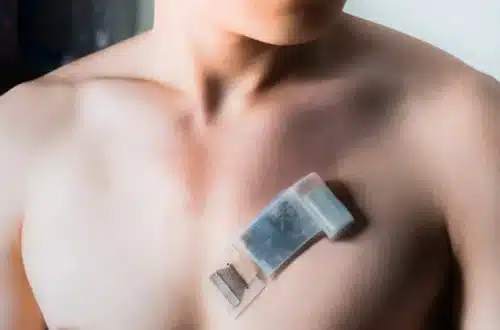Researchers at the University of California have developed an integrated wearable ultrasound system for tracking deep-tissue activity.

Incorporating ultrasound technology into wearable devices has the potential to be a life-saving advancement. However, the integration of ultrasound into wearables poses various challenges, including miniaturization, accuracy, and power consumption.
Engineers at the University of California San Diego have achieved a significant milestone by developing the world’s first fully integrated wearable ultrasound system capable of tracking deep-tissue activity. The project offers a holistic wearable ultrasound solution, encompassing the sensor and control electronics in wearable form. The device can wirelessly detect vital signs in deep tissue.
This work incorporates a flexible control circuit that wirelessly communicates with an ultrasound transducer array. Machine learning interprets data and tracks moving subjects. Ultrasonic system-on-patch (USoP) tracks deep physiological signals (164mm) for 12 hours, measuring blood pressure, heart rate, and more. The technology offers real-time measurement of exercise-related cardiovascular responses, aiding in personalized training plans. During development, the team was pleasantly surprised by the additional capabilities of their innovation. Initially focused on a wireless blood pressure sensor, they discovered it could measure vital physiological parameters like cardiac output, arterial stiffness, and more, crucial for healthcare monitoring.
The subject’s movement creates a challenge as the wearable ultrasonic sensor needs frequent readjustment. The team tackled this by developing a machine-learning algorithm that analyzes signals and selects the optimal channel to track the moving target. However, inconsistency arises when training the algorithm with one subject’s data, making the results unreliable for other subjects. The generalization in the machine learning model is achieved by employing an advanced adaptation algorithm. This algorithm minimizes distribution discrepancies between subjects, enabling the transferability of machine intelligence. By training the algorithm on one subject, we can apply it to numerous new subjects with minimal retraining.
In future, the sensor will undergo testing on larger populations. As envisioned by the researchers, the device is the future of deep-tissue monitoring.
Reference: “A fully integrated wearable ultrasound system to monitor deep tissues in moving subjects” by Muyang Lin, Ziyang Zhang, Xiaoxiang Gao, Yizhou Bian, Ray S. Wu, Geonho Park, Zhiyuan Lou, Zhuorui Zhang, Xiangchen Xu, Xiangjun Chen, Andrea Kang, Xinyi Yang, Wentong Yue, Lu Yin, Chonghe Wang, Baiyan Qi, Sai Zhou, Hongjie Hu, Hao Huang, Mohan Li, Yue Gu, Jing Mu, Albert Yang, Amer Yaghi, Yimu Chen, Yusheng Lei, Chengchangfeng Lu, Ruotao Wang, Joseph Wang, Shu Xiang, Erik B. Kistler, Nuno Vasconcelos and Sheng Xu, 22 May 2023, Nature Biotechnology.
DOI: 10.1038/s41587-023-01800-0






